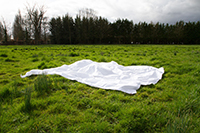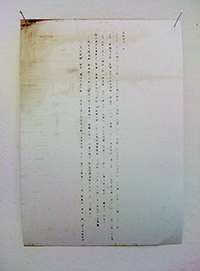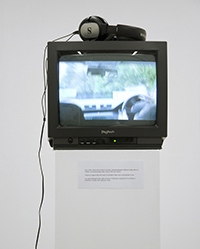Agata Engelman
about
contact
life does not frighten me
SVLBRD
albedo
eye for an eye
boat
plane
waterfall
storm
The Great Flood 7209
prayers
yellow sky
[untitled]
soundtrack
piernik
research
A0 pentaptych
Shh.. my child, I will make your love eternal
When the ice is gone, we are left in the dark.
Albedo is the reflection coefficient of a surface, it indicates how much energy coming from the...
During my residency at DAR I made a word cloud out of comments people leave below articles about the shoot-on-sight policy at the Kaziranga National Park...
short video
short video
happening
short video
short video
church prayers typed from memory using a faulty typewriter
short video
four short 6-screen videos
soundtrack to a taxi journey
table, gingerbread, framed photo, writing on a wall
Tomorrow in a year. The politics of Ips typographus.
In my doctoral project I look at the conflict surrounding the protection of Poland's Bialowieza Forest...
Tomorrow in a year. The politics of Ips typographus.
In this research project I look at the conflict surrounding the protection of Poland’s Białowieża Forest linked to the outbreak of bark beetle (Ips typographus) infestation, which caused a large number of the forest's spruces to die. Split between Poland and Belarus, Białowieża Forest is the largest remainder of vast primeval forests that used to cover this part of lowland Europe. Protected for centuries by kings and tsars as their hunting grounds, it remained largely untouched by human activity and is a unique habitat of a wide range of plants, animals and fungi, many of which cannot be found anywhere else, but, most importantly, a place to observe the spontaneous processes of an old ecosystem.
I propose to look at the conflict around Białowieża Forest as a clash of two worldviews. On one side there is the Ministry of Environment and the National Forestry Agency, on the other the majority of Polish biologists and environmentalists. At least to a certain extent, both sides of the conflict agree on the goal, which is the protection of Białowieża Forest. It is clear, however, that they differ fundamentally not only in how they intend to protect it, but actually what it is that they intend to protect. It is therefore as much a matter of ontology as it is of epistemology and politics that arise from them. I argue that the governmental stance is fundamentally anthropocentric and sees the forest as a national resource, which ought to be actively protected and managed, through cutting and logging the infected trees in order to maintain the green and healthy forest. The other group postulates what I propose to call a posthumanist approach - more passive protection, where the prerogative is not to interrupt the spontaneous ecosystemic processes, even if it leads to a change in species composition.
This case presents an interesting perspective on the clash of different knowledge practices and different forms of rationality. Both sides share a similar goal, at least to a certain extent - to protect the Białowieża Forest. This common aim makes the differences in the fundamental assumptions even starker. There isn’t even, as I attempt to prove, a common ground as to what counts as a form of rationality. Knowledge practices and epistemologies are directly related to politics - but they are also connected to aesthetics and discourse.
An interesting point of analysis that seems to be revealing these relationships through discourse analysis is the time perspective. Those speaking for the ministry often speak of things like the forest looking different than when they were children – human perspective used by the ministry who wants the forest to look the same again in their lifespan and for the next (human) generations. The time perspective may be completely different for the ecosystem. The title of my project, Tomorrow in a year, is a play on the title of an electro-opera by The Knife – Tomorrow, in a year - based on Charles Darwin's biography and his On the Origin of Species. Tomorrow in a year stands here to represent a different, nonhuman, perception of time. A tree can live hundreds of years, its tomorrow may be in our year. Aesthetic perspective also reveals a lot about the underlying ontologies – the ministry and their supporters bring up images of grey, dead trees as proof that action is necessary, because the Białowieża Forest should be green and tidy. They talk about the specific smell of decomposing wood, suggesting it means illness. Green-washing, a trend in conservation to value green and leafy plants over those less aesthetically appealing is a serious and well-known problem, not just in Białowieża, but also elsewhere. Aesthetics is further linked directly with charisma, a concept crucial for conservation, where certain species / ecosystems / locations attract public attention, which has both good and bad consequences (more money for pandas but also more people want to look at them in zoos).
for more information about the conflict:
https://www.clientearth.org/final-legal-warning-polish-government-prepares-log-bialowieza-forest/
http://www.polishwolf.org.pl/bialowieza-forest
https://www.theguardian.com/environment/2017/may/23/worst-nightmare-europes-last-primeval-forest-brink-collapse-logging
http://alert-conservation.org/issues-research-highlights/2017/6/9/europes-last-great-old-growth-forest-faces-the-axe
In this research project I look at the conflict surrounding the protection of Poland’s Białowieża Forest linked to the outbreak of bark beetle (Ips typographus) infestation, which caused a large number of the forest's spruces to die. Split between Poland and Belarus, Białowieża Forest is the largest remainder of vast primeval forests that used to cover this part of lowland Europe. Protected for centuries by kings and tsars as their hunting grounds, it remained largely untouched by human activity and is a unique habitat of a wide range of plants, animals and fungi, many of which cannot be found anywhere else, but, most importantly, a place to observe the spontaneous processes of an old ecosystem.
I propose to look at the conflict around Białowieża Forest as a clash of two worldviews. On one side there is the Ministry of Environment and the National Forestry Agency, on the other the majority of Polish biologists and environmentalists. At least to a certain extent, both sides of the conflict agree on the goal, which is the protection of Białowieża Forest. It is clear, however, that they differ fundamentally not only in how they intend to protect it, but actually what it is that they intend to protect. It is therefore as much a matter of ontology as it is of epistemology and politics that arise from them. I argue that the governmental stance is fundamentally anthropocentric and sees the forest as a national resource, which ought to be actively protected and managed, through cutting and logging the infected trees in order to maintain the green and healthy forest. The other group postulates what I propose to call a posthumanist approach - more passive protection, where the prerogative is not to interrupt the spontaneous ecosystemic processes, even if it leads to a change in species composition.
This case presents an interesting perspective on the clash of different knowledge practices and different forms of rationality. Both sides share a similar goal, at least to a certain extent - to protect the Białowieża Forest. This common aim makes the differences in the fundamental assumptions even starker. There isn’t even, as I attempt to prove, a common ground as to what counts as a form of rationality. Knowledge practices and epistemologies are directly related to politics - but they are also connected to aesthetics and discourse.
An interesting point of analysis that seems to be revealing these relationships through discourse analysis is the time perspective. Those speaking for the ministry often speak of things like the forest looking different than when they were children – human perspective used by the ministry who wants the forest to look the same again in their lifespan and for the next (human) generations. The time perspective may be completely different for the ecosystem. The title of my project, Tomorrow in a year, is a play on the title of an electro-opera by The Knife – Tomorrow, in a year - based on Charles Darwin's biography and his On the Origin of Species. Tomorrow in a year stands here to represent a different, nonhuman, perception of time. A tree can live hundreds of years, its tomorrow may be in our year. Aesthetic perspective also reveals a lot about the underlying ontologies – the ministry and their supporters bring up images of grey, dead trees as proof that action is necessary, because the Białowieża Forest should be green and tidy. They talk about the specific smell of decomposing wood, suggesting it means illness. Green-washing, a trend in conservation to value green and leafy plants over those less aesthetically appealing is a serious and well-known problem, not just in Białowieża, but also elsewhere. Aesthetics is further linked directly with charisma, a concept crucial for conservation, where certain species / ecosystems / locations attract public attention, which has both good and bad consequences (more money for pandas but also more people want to look at them in zoos).
for more information about the conflict:
https://www.clientearth.org/final-legal-warning-polish-government-prepares-log-bialowieza-forest/
http://www.polishwolf.org.pl/bialowieza-forest
https://www.theguardian.com/environment/2017/may/23/worst-nightmare-europes-last-primeval-forest-brink-collapse-logging
http://alert-conservation.org/issues-research-highlights/2017/6/9/europes-last-great-old-growth-forest-faces-the-axe


















